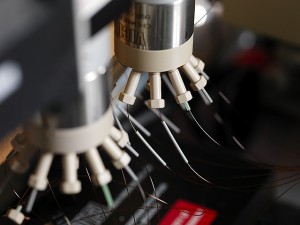New technique could speed up protein-specific diagnostic testing performed by the nation’s clinical pathology laboratories
There is a growing role for mass spectrometry in clinical laboratory testing. However, the pace of adoption will depend on further technology enhancements, in tandem with new clinical applications yet to emerge from research laboratories.
One such innovation was announced by researchers at the Department of Energy’s Pacific Northwest National Laboratory (PNNL). They developed a new technique that uses mass spec to identify protein biomarkers associated with cancer and other diseases. In the PNNL news release, researchers called the technique PRISM. The acronym stands for Proteomics Research Information System and Management. This e-briefing is based on the PNNL news release.
Mass Spec versus Antibody-based Clinical Assays
The PNNL research team compared their technique to the standard antibody-based ELISA in tests of blood samples from cancer patients. Results showed that mass spec performed as accurately as ELISA.
The new technology could speed up development of protein-specific diagnostic tests and treatment. This is because ELISA testing requires an antibody, which takes time to produce. “[I]t often takes a year and a half to develop antibodies as tools,” explained PNNL bioanalytical chemist, Wei-Jun Qian, Ph.D., lead author on the study.

New research conducted by the Department of Energy’s Pacific Northwest National Laboratory (PNNL) showed that it was possible to use mass spectrometry to identify protein biomarkers with equal or better sensitivity and accuracy than antibody-based clinical tests. PNNL used protein biomarkers associated with cancer and other diseases in its study. The new technique is called PRISM and could speed the acceptance of mass spec for clinical laboratory testing purposes. (Photo copyright PNNL.)
As pathologists and medical laboratory scientists know, it takes time for a person to produce an antibody in response to an infection or malignancy. Thus, use of an antibody-based test during the time before the patient’s system has produced the antibody could result in a false negative. This was the case with antibody-based HIV testing in the late 1980s. It took six months for the antibody to show up in an HIV-infected person.
Both approaches to testing have drawbacks. Conventional mass spec lacks ELISA’s sensitivity to detect rare proteins that exist in very low concentrations, noted Quian. The requirement of an antibody for ELISA testing makes this method expensive, as well as time-consuming. “Antibody development is one of the bottlenecks for new biomarker studies in disease and systems biology research,’ Qian noted. Another issue in antibody-based assays is the possibility of cross-reactivity, or unintended binding.
The PNNL researchers found a way to quantify biomarkers without using an antibody. Instead, they used high performance liquid chromatography (HPLC) to synthesize proteins that they added to the specimen. After sending the specimen through the mass spec instrument, they were able to easily detect the synthesized proteins. The synthesized proteins also indicated the presence of the targeted biomarker.
To prove PRISM’s effectiveness in finding rare proteins, the researchers added prostate specific antigen (PSA) to samples from females. Only males produce PSA. They found they could measure PSA with the same sensitivity typical of ELISA testing. Further, the PRISM test performed at roughly 100 times the sensitivity level of conventional mass spec.
“This is a breakthrough in sensitivity without using antibodies,” declared Qian.
Mass Spec Outperforms ELISA in PSA Tests
In subsequent comparison tests using samples from male cancer patients, PRISM measured three times more PSA than the ELISA assay. The findings suggested that ELISA testing fails to measure all of the forms of the biomarker. Qian explained that this is likely because antibodies do not recognize all the variations of the protein. PRISM, on the other hand, measured the total amount of protein.
Researchers believe that mass spec-based tests could address the existing drawbacks of antibody-based testing. These drawbacks include higher cost, long antibody production times, and cross-reactivity issues.
There is another sign of the growing interest in the use of mass spectrometry for clinical laboratory testing purposes. It is the growth in membership for the trade association known as Mass Spectrometry: Applications to the Clinical Lab (MSACL). As well, attendance at MSACLS’s annual meeting has skyrocketed in recent years. These are additional signs of that the use of mass spec for clinical laboratory testing is growing.
—Pamela Scherer McLeod
Related Information:
Mass spec makes the clinical grade
THE DARK REPORT: Quest Discusses Use of Mass Spec Methodology



